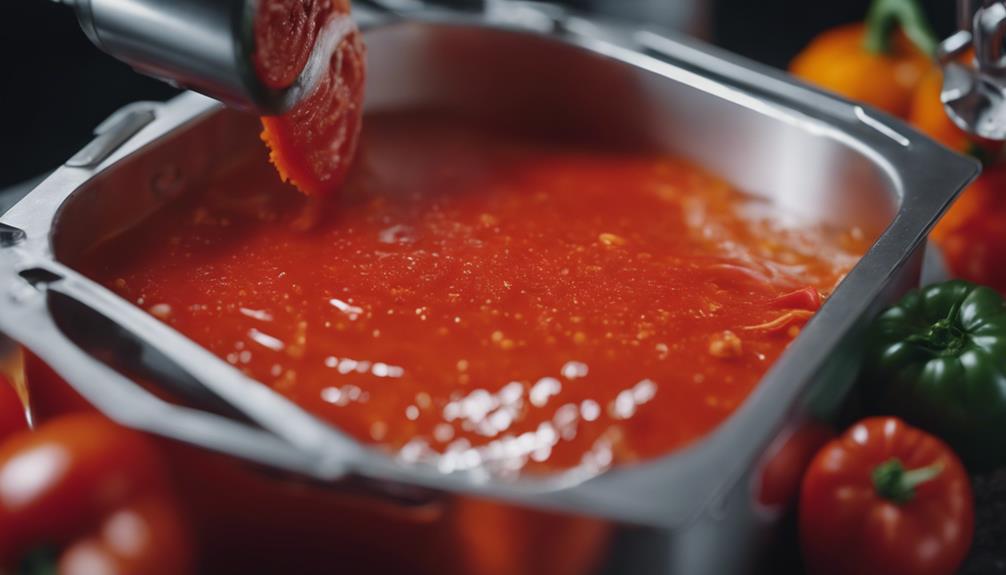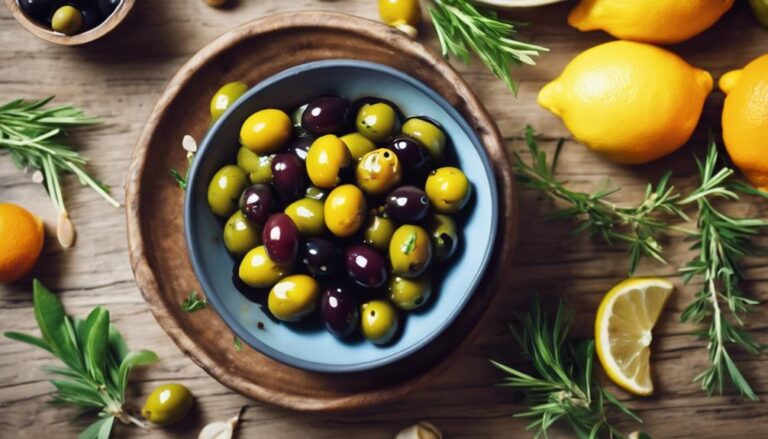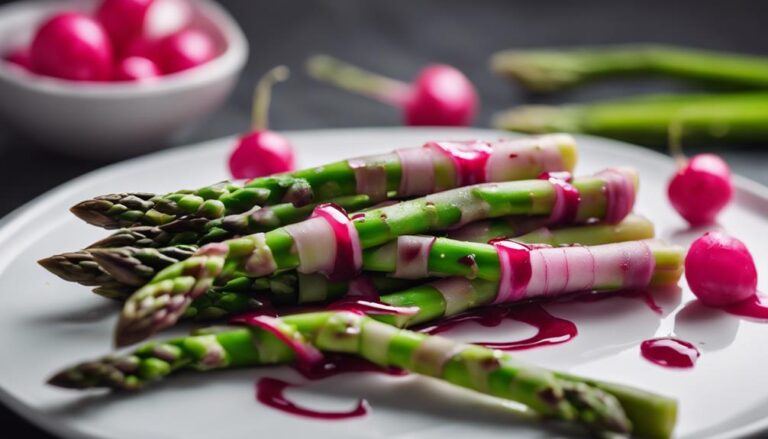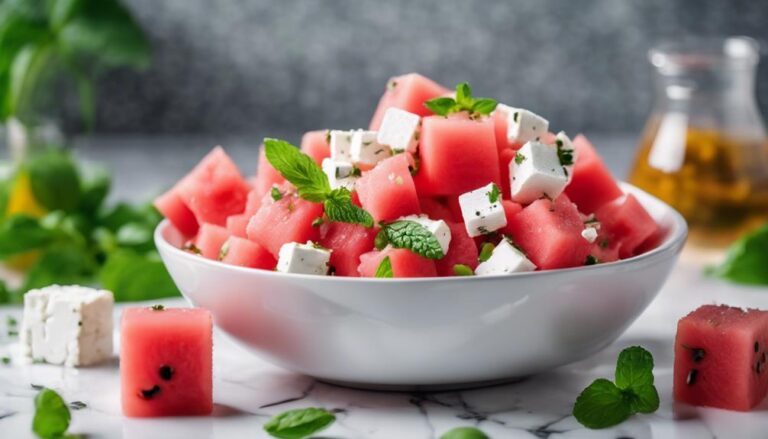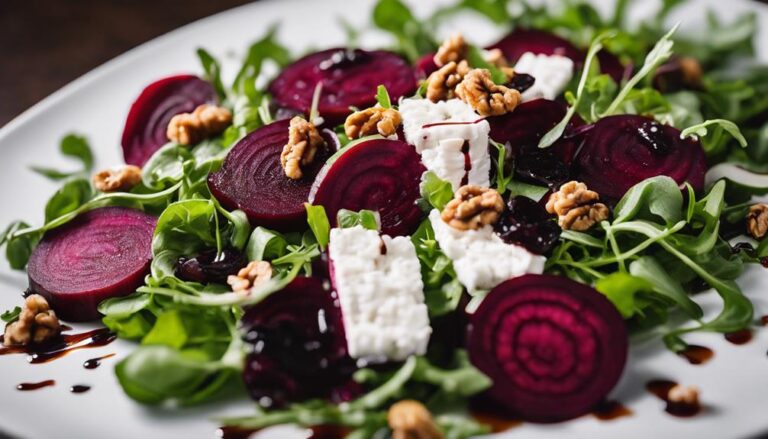Sous Vide Tomato and Red Pepper Soup
To create a delicious sous vide tomato and red pepper soup, start by selecting ripe tomatoes and peppers for best flavor. Utilize cooking techniques like roasting and sous vide to enhance taste and texture. Sous vide cooking requires precise temperature control using a water bath and a machine to regulate temperature accurately. This method guarantees consistent results and prevents overcooking or undercooking. By maintaining precise temperature throughout, you can achieve perfect doneness and intense flavor profiles in your soup. Experiment with garnishes to elevate the dining experience. Elevate your culinary skills with this sophisticated soup preparation method.
What You Will Learn Here
- Sous vide ensures precise temperature control for perfect cooking results.
- Use high-quality, fresh tomatoes and red peppers for optimal flavor.
- Experiment with roasting and sous vide techniques for enhanced taste.
- Garnishes can elevate the soup's flavor profile and visual appeal.
- Vacuum-sealing ingredients in sous vide preserves natural flavors and textures.
Soup's Origin: Ancient Roman Roots

The roots of soup can be traced back to ancient Roman times, where it held significant culinary importance. Romans greatly influenced the development of soups through their use of traditional ingredients and cooking techniques.
Exploring Roman soup history provides insights into the diverse range of flavors and ingredients that continue to influence modern soup-making practices.
Roman Soup History
Having its roots in ancient Rome, soup's history intertwines with the culinary traditions of the Mediterranean region. Roman culinary traditions played a significant role in shaping the evolution of soups as they're understood today. In ancient Rome, soups were a staple part of the diet, consumed at almost every meal. These soups were often made with ingredients like vegetables, herbs, grains, and sometimes meat or fish, reflecting the availability of produce in the region.
The Romans' penchant for flavorful broths and hearty dishes laid the foundation for the diverse range of soups found in modern cuisine. They incorporated various cooking techniques and seasonings to create rich and savory soups that were both nourishing and delicious. Over time, this culinary influence spread throughout Europe and beyond, contributing to the global popularity of soups.
Understanding the Roman origins of soup provides insight into the rich tapestry of flavors and techniques that have been passed down through generations. The next time you enjoy a warm bowl of soup, remember the ancient Romans and their contributions to this comforting culinary tradition.
Culinary Influence Traces
With ancient Rome as its culinary birthplace, soup's origins trace back to the rich and diverse flavors of Mediterranean cooking. Culinary innovations in ancient Rome played a significant role in shaping the soup as it's understood today. Historical influences from various cultures, such as the Greeks and Egyptians, also contributed to the development of soups during this time.
During the Roman Empire, soups were a staple part of the diet and were often consumed at the beginning of meals. Ingredients like vegetables, herbs, and meats were commonly used to create flavorful broths and stews. The Romans even developed specialized cookware, such as the patella and the olla, to prepare and serve these dishes.
Roman culinary techniques, including simmering ingredients together to enhance flavors, laid the foundation for modern soup-making practices. The tradition of using simple, fresh ingredients to create hearty and nourishing soups has endured through the centuries, reflecting the enduring legacy of ancient Roman cuisine in today's culinary landscape.
Traditional Ingredients Used
Exploring the historical roots of soup, investigate the traditional ingredients that formed the foundation of ancient Roman cuisine. Ancient Romans, known for their gastronomic prowess, used a variety of ingredients that are still staples in modern cooking. The Romans incorporated vegetables like onions, garlic, and leeks to add depth and flavor to their soups. They also made use of herbs such as parsley, thyme, and bay leaves for seasoning. In addition, the addition of barley or wheat grains provided thickness and texture to their soups.
These traditional techniques have stood the test of time, influencing the way soups are prepared today. While modern twists have been introduced, the essence of using fresh, simple ingredients remains at the core of creating flavorful soups. By understanding the traditional ingredients and techniques used in ancient Roman cuisine, one can appreciate the rich history and evolution of soup-making. Embracing these roots allows for a deeper connection to the culinary heritage that continues to inspire chefs and home cooks alike.
Key Soup Components
For a flavorful and well-balanced soup, focus on selecting the freshest tomatoes and red peppers. To guarantee your soup hits all the right notes, pay attention to the following key components:
- Flavor Profiles: Choose tomatoes and red peppers that are ripe and bursting with natural sweetness to enhance the overall taste of the soup.
- Texture Contrast: Incorporate a variety of textures by blending some ingredients for a smooth base while leaving others slightly chunky for a satisfying mouthfeel.
- Ingredient Freshness: Opt for high-quality, fresh produce to elevate the flavors of your soup and ensure a vibrant color and rich taste.
- Cooking Techniques: Experiment with different cooking methods like roasting the vegetables before sous vide cooking to deepen the flavors and add complexity to the soup.
Tasty Soup Variations
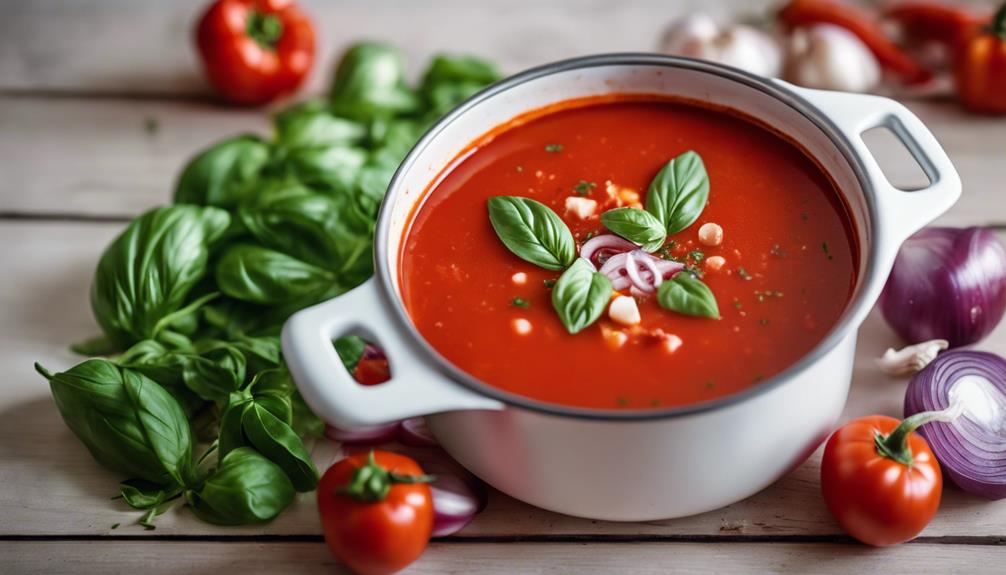
When it comes to tasty soup variations, you have some exciting options to explore. Consider trying out a delicious Sous Vide Gazpacho Recipe, a flavorful Sous Vide Ratatouille Soup, or a hearty Sous Vide Minestrone Soup.
These variations offer unique flavors and textures that can elevate your soup game and add a touch of creativity to your culinary repertoire.
Sous Vide Gazpacho Recipe
Consider incorporating the sous vide cooking technique to elevate your gazpacho soup with a unique depth of flavor and texture. By using sous vide, you can enhance the natural taste of the ingredients while maintaining their nutrients. Here are some tips to help you make the most flavorful sous vide gazpacho:
- Precise Temperature Control: Sous vide allows you to cook your ingredients at a consistent and exact temperature, ensuring excellent flavor infusion.
- Longer Cooking Times: Longer cooking times at lower temperatures allow the flavors to meld together perfectly, resulting in a rich and well-balanced gazpacho.
- Vacuum Sealing: Vacuum-sealing your ingredients before cooking helps retain their natural juices and flavors, leading to a more intense taste.
- Chill Before Serving: After sous vide cooking, chill your gazpacho thoroughly before serving to let the flavors fully develop and create an invigorating dish.
Sous Vide Ratatouille Soup
To further expand your repertoire of sous vide soups, explore the delectable flavors of Sous Vide Ratatouille Soup, a delightful variation that promises a burst of Mediterranean-inspired goodness.
- Incorporate sous vide techniques for a modern twist on this classic dish.
- Enjoy the convenience of preparing all the ingredients in advance and letting them infuse flavors slowly.
- Experiment with different vegetable combinations to personalize your ratatouille soup.
- Elevate the dish by finishing it off with a drizzle of high-quality olive oil before serving.
Sous Vide Ratatouille Soup offers a fresh take on the traditional French stewed vegetable dish. By using sous vide techniques, you can intensify the flavors of the vegetables while maintaining their nutrients. This modern twist allows you to enjoy a vibrant and healthy soup with minimal effort. Customizable and easy to prepare, Sous Vide Ratatouille Soup is a must-try for anyone looking to explore the versatility of sous vide cooking in creating delicious and nutritious meals.
Sous Vide Minestrone Soup
Explore the flavorful world of sous vide cooking with a tantalizing twist on the classic Minestrone soup. This hearty Italian dish is elevated through the precision of sous vide, allowing the flavors to meld perfectly while maintaining the integrity of each ingredient. Here's how you can create a mouthwatering Sous Vide Minestrone Soup:
- Flavorful broth: Start with a rich and savory broth base, simmered to perfection with herbs and spices.
- Seasonal vegetables: Utilize a colorful array of seasonal vegetables like zucchini, carrots, tomatoes, and beans to add depth and variety to your soup.
- Cooking sous vide: Seal the ingredients in a bag and let them cook in a water bath at a precise temperature, ensuring ideal infusion of flavors.
- Finishing touches: Before serving, garnish your Sous Vide Minestrone Soup with fresh herbs and a drizzle of high-quality olive oil for a burst of freshness.
Indulge in a bowl of Sous Vide Minestrone Soup for a delicious and comforting meal that's sure to impress your taste buds.
Sous Vide Temperature Control
When it comes to sous vide cooking, precise temperature regulation is crucial. This method guarantees consistent cooking results every time you prepare a dish.
Additionally, maintaining the ideal temperature enhances flavor retention, resulting in delicious and well-developed flavors in your food.
Precise Temperature Regulation
For ideal results in sous vide cooking, maintaining precise temperature control is essential. Temperature accuracy is vital in sous vide cooking to guarantee cooking precision. The sous vide technique relies on water baths set at specific temperatures to cook food perfectly.
To achieve this, you need a sous vide machine that can regulate the water temperature with high accuracy. This precision allows you to cook your ingredients to the exact doneness you desire, whether it's a medium-rare steak or a tender vegetable dish.
Consistent Cooking Results
To guarantee consistent cooking results in sous vide cooking, maintaining precise temperature control throughout the entire cooking process is essential. Sous vide cooking techniques rely on keeping the water temperature constant to make certain that your ingredients are cooked evenly and with reliable outcomes every time. By setting the water bath to the exact temperature needed for your recipe, you can achieve consistent results without worrying about overcooking or undercooking your food.
The beauty of sous vide cooking lies in its ability to deliver precise and consistent results with minimal effort on your part. Whether you're preparing a delicate tomato and red pepper soup or a perfectly cooked steak, the sous vide method allows you to achieve the desired level of doneness with accuracy. This level of control over the cooking process ensures that your dishes turn out consistently delicious, making sous vide a popular choice for home cooks and professional chefs alike.
Mastering the art of maintaining precise temperature control is key to tapping into the full potential of sous vide cooking and enjoying reliable results with every meal you prepare.
Enhanced Flavor Retention
Maximize the flavor retention of your ingredients through precise temperature control in sous vide cooking. Sous vide, a gentle cooking technique, allows you to infuse your ingredients with flavor while preserving their natural taste. By vacuum-sealing your tomato and red pepper soup ingredients and cooking them at a consistent low temperature for an extended period, you guarantee that the flavors are preserved, resulting in a rich and vibrant final dish.
The controlled environment of sous vide cooking prevents the loss of volatile compounds that contribute to the overall taste of your soup. Unlike traditional cooking methods where flavors can evaporate or degrade due to high heat, sous vide maintains the integrity of each ingredient, leading to a more intense and satisfying flavor profile.
Whether you're looking to enhance the sweetness of ripe tomatoes or intensify the smokiness of red peppers, sous vide temperature control is your key to achieving excellent flavor infusion. Experiment with different cooking times and temperatures to find the perfect balance for your tomato and red pepper soup, revealing a depth of flavor that will impress your taste buds.
Final Thoughts
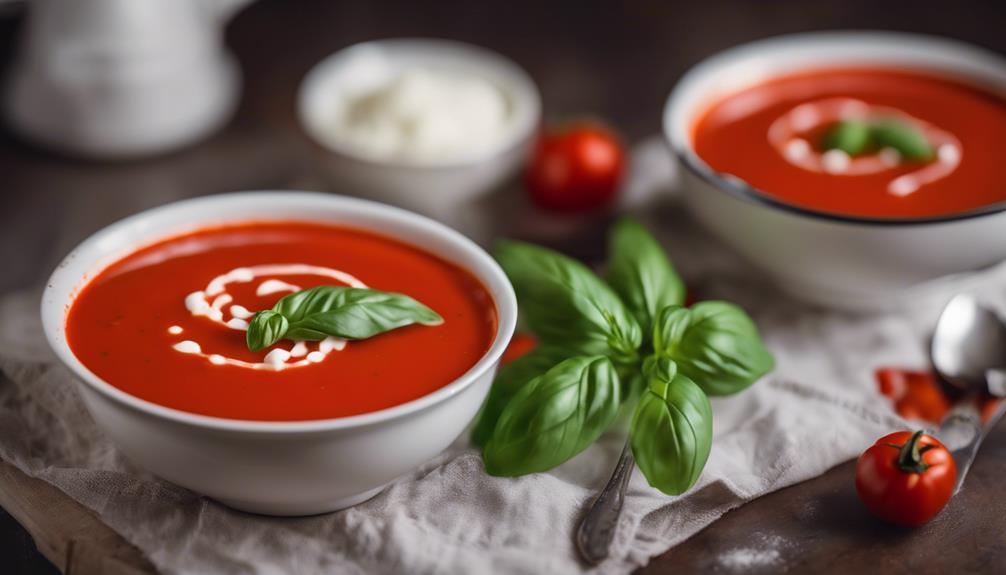
Consider incorporating a variety of garnishes to elevate the flavor profile of your soup. Reflect on your cooking process and the results achieved. The sous vide method preserves the vibrant flavors of the tomatoes and red peppers while enhancing the overall taste of the soup. Each ingredient contributes to the rich and velvety texture that characterizes this dish.
When adding garnishes, think about complementing the existing flavors. Fresh basil leaves can add a touch of freshness, while a drizzle of balsamic reduction can provide a hint of sweetness and acidity. A dollop of crème fraîche or a sprinkle of Parmesan cheese can introduce creaminess and depth to the soup.
As you experiment with different garnishes, take note of how each one influences the overall flavor profile. Consider how the textures and flavors interact with the base soup. By carefully selecting and combining garnishes, you can create a truly memorable dining experience for yourself and your guests. Let your creativity shine as you put the finishing touches on your sous vide tomato and red pepper soup.
Frequently Asked Questions
Can This Soup Be Made Spicy for Those Who Enjoy Heat?
If you want to make a dish spicy for heat lovers, explore spicy variations like adding chilies or hot sauces. Try flavor pairings with ingredients like jalapeños, cayenne pepper, or red pepper flakes for extra kick.
Are There Any Recommended Garnishes to Elevate the Soup?
To elevate the soup, consider garnishing with options like fresh herbs, croutons, or a dollop of sour cream. These additions enhance flavor profiles and add a touch of culinary creativity to the presentation, making the dish more visually appealing.
Can This Soup Be Served Cold as a Gazpacho Alternative?
If you prefer a chilled dish, consider serving this soup cold for a gazpacho alternative. Enjoy it with invigorating garnishes like diced cucumbers or croutons. Adjusting the temperature can offer new flavor variations to your meal.
How Can the Soup Be Stored for Future Consumption?
For future consumption, you can store the soup by freezing portions in airtight containers for up to 3 months. When ready to eat, simply thaw in the fridge overnight or reheat gently on the stove.
Can the Recipe Be Adjusted for a Creamier Texture?
To achieve a creamier consistency in your dish, consider adding ingredients like heavy cream or blended cashews. These additions not only enhance the flavor but also create a rich and velvety texture that will elevate your recipe.
Conclusion
Overall, sous vide tomato and red pepper soup is a delicious and convenient dish that combines ancient flavors with modern cooking techniques.
By meticulously controlling the temperature during the sous vide process, you can guarantee a perfect blend of flavors and textures in every spoonful.
Whether you stick to the classic recipe or experiment with tasty variations, this soup is sure to impress your taste buds.
So why not give it a try and elevate your soup game today?
